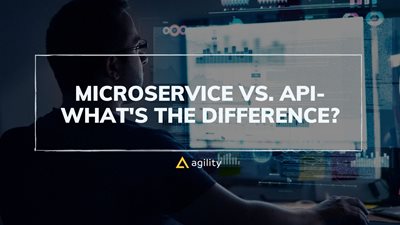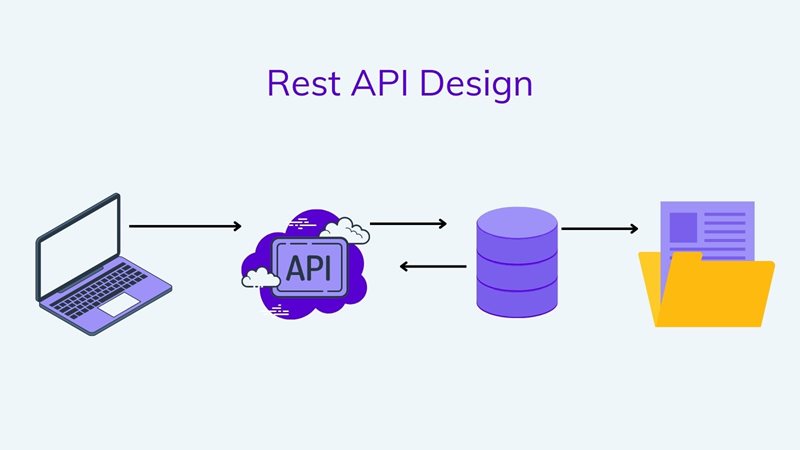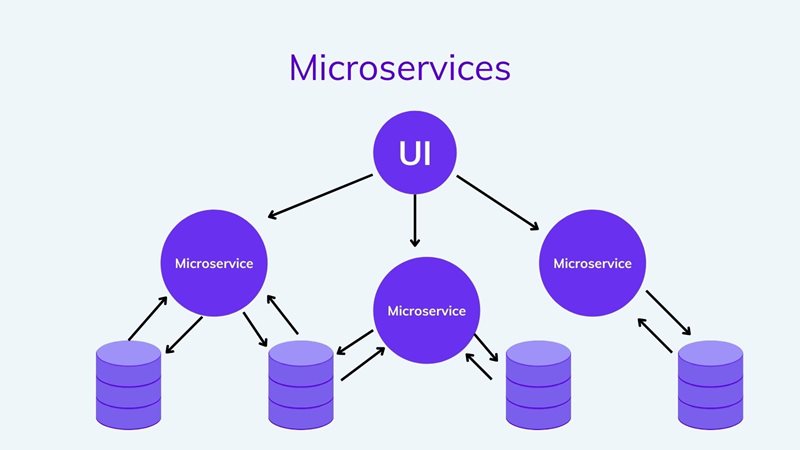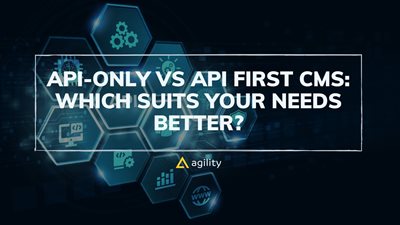Microservice vs. API- What's the difference?
Discover the differences between microservices vs APIs.


Be conscious of the implementation and architecture of your software when creating new features and code. You'll get the best results from your program when it's written in a way that sounds logical. Additionally, software should consider the user's interaction and the interface the user will encounter.
Both APIs and Microservices have to do with the internal workings of computer programs. A Microservice is often misunderstood as nothing more than an API endpoint.
However, Microservices are far more flexible and capable than that. Therefore, this article will explain more about Microservice vs. API, when/why to use APIs and Microservices, and why API versioning is essential. Further, you will also learn about why to use Rest API and the role of Microservices. Let's get started!
What is an API?

API is a set of Subroutine specifications, communication protocols, and software development tools. In other words, it's a collection of well-defined communication ways between distinct components.
One way to conceive of an API is as a contract of activities you can request for a specific service. APIs are contracts. Many web apps utilize APIs, including social networking, banking software, and much more. Using a standard contract, external programs can communicate with one another.
For example, let's imagine you're developing a Facebook-integrated application. Using the Facebook Graph API, you would be able to get information about Facebook users, posts, and comments. The API makes it easier for developers to access Facebook's data because it abstracts away its complexities.
Moreover, there are various actions frequently performed by APIs. RESTful styles are the norm in today's world of API development. A sequence of verbs that correspond to HTTP activities will be used in these APIs:
- The GET method is used to get an item or collection.
- POST can use to add an item to a collection.
- PUT is usually used to edit an existing item in a collection.
- DELETE can obviously use to delete an item in a collection.
Having a standard for various actions is a benefit of this uniformity across different applications. The four HTTP verbs listed above correspond to the standard CRUD functionality seen in many modern apps. With multiple APIs in one application, it is easy to see how the actions made across the various interfaces impact each other.
What are Rest APIs?

A REST API, often known as a RESTful API, is an application programming interface that adheres to the REST architectural style and enables communication with RESTful web services. REST is an acronym for "representative state transfer."
You may have the question in your mind- why use Rest API? It's because REST is a collection of architectural constraints, not a protocol or standard. In order to implement REST, API developers have a range of options.
However, a representation of the resource's current state is delivered to the requester or endpoint when a RESTful API is used for client requests. JSON, HTML, and others are some formats in which this information is supplied via HTTP. If you're looking to save data in a file format that both humans and machines can read, JSON is your best option.
An additional consideration is that the HTTP methods used by a RESTful API HTTP request include headers and parameters that contain critical identification information such as the request's metadata and authorization code and cache information and cookie information. The HTTP connection information and status codes are contained in the request and response headers.
Why use API?
The question arises why use API. Since APIs are a safe mechanism for both internal and external users to request and share content, services, and functionalities. Microservices might not exist if we didn't have APIs to work with. Checking out online, for example, is an illustration of this.
GPay is an option, and you already have an account and payment information set up. What a time-saver, am I right?
Because the online store you're viewing is not affiliated with Google Pay, an API is required to connect the two. The store's API will ask for access to payment details in this case. GPay's API will save the request, validate it, collect the data from the database, and transmit it to the store to complete the transaction. GPay.com
APIs aren't just for interfacing with other applications; they're also for connecting with the microservices that make up the application. It improves the service's accessibility and visibility.
APIs make it easier for developers to get at the data they need by making it easier to use the data in other services. Individual microservices can communicate with each other using this lightweight Method.
Sending data over HTTP and receiving a JSON response are the most common methods for APIs to exchange information. SOAP, REST, GraphQL, and other API design patterns are only a few examples.
Why is API versioning important?

Next, let's get to know why API versioning is essential. For some inexplicable reason, APIs exist in two forms. On the one hand, this means that you're building a digital product that other software developers can use.
In addition to the data itself, your product also can access and use it. As many developers depend on the service's reliable API, any modifications might immediately cause problems. Traditional software typically fixes flaws in subsequent releases. APIs, on the other hand, often deny designers that luxury.
So, to assure that your product keeps giving your customers new options without the need to update, API Versioning is the technique of creating collaborative data sharing and editing tools. The API architecture incorporates versioning as a fundamental component. New API versions can be developed without affecting client applications, allowing for a smoother transition from one version to another. Customers can continue utilizing an old REST API and migrate or update their apps to the latest API versions just once they are able.
What is Microservice?

The term "service" can be boiled down to two words: "micro" for little and "action" for service. A microform of action, then, can be done after a task has been completed.
In today's software development, microservices, or microservice architectural patterns, are used to structure loosely linked services. Similar to an assembly line, each service performs a specialized task. All of these services work together to create a complete application. Smaller components known as services are loosely connected, independently deployable, highly maintained, tested, controlled by a small development team, and structured around business functions in a microservices architecture.
It is also possible to deliver complicated, long-running applications with microservices. The success of microservice architecture is mainly due to its ease of development, integration, and management. Developers can create apps piecemeal and work on individual services without interfering with the operation of other services.
Microservices may opt to use APIs as a means of inter-service communication (IPC), but they also play an essential part in software design. Technical debt grows as the complexity of a program increases. A "huge ball of mud" is a codebase that grows increasingly difficult to maintain and adapt as more added features.
By splitting down your monolithic application's logic into little bits, microservice architecture (MSA) aims to overcome this problem (i.e., services). If a defect happens in one microservice, you don't lose all of your software's functionality. Customers can still examine products even if your shopping cart microservice goes down, for example, by engaging with your product catalog microservice.
One drawback to MSA is that it demands more rigorous design considerations, such as how to fulfill requests that require the cooperation of numerous microservices or what IPC best suits a specific use case. It is common for distinct microservices to require varying memory and CPU power.
Why use Microservices?
To comprehend the utilization of microservices, one must first understand monolith architecture. The monolithic architecture is a typical model for creating a computer program containing all features in a single massive block.
It means that all of the application's components, including the data access layer, business logic layer, and UI layer, are stored in one location. Adding new features or functionality becomes tough with such a huge and sophisticated design. Everything in a monolithic design is so intertwined that it's impossible to separate it from the rest.
Microservices Architecture outperforms Monolithic Architecture in many ways. Let's get to know them.
- Firstly, a developer doesn't need to know everything about the application in order to grasp one aspect of it.
- Secondly, even if a single service fails, the complete software will continue to function. This is due to the application's modular design.
- Thirdly, an update doesn't necessitate rewriting the entire system, which saves money and time and the work of debugging.
- In a security breach, no other services are adversely affected.
- Finally, an independent program code and framework can be used for some application services without affecting others, allowing for flexibility.
As a result of decoupling responsibilities, software development can be simplified and expedited using microservices. It's not clear how all discrete parts will communicate and work together. If you'd like to know, then API comes into play.
What is the purpose of microservices?
Microservices make an application more adaptable to changing circumstances. This has a wide range of applications, including the following:
- If you are still utilizing a legacy design, leveraging microservices to shift to the cloud, update functionality, and add new features would enable you to create incrementally while reducing the amount of technical complexity involved.
- Microservices allow for the execution of activities in real-time and the delivery of rapid outputs. Examples of platforms that use microservices include online booking services and banking platforms.
- You may make third-party apps like plugins run more efficiently by utilizing microservices. These applications demand additional CPU power to function.
What's the difference: Microservice vs. API?

Below you can see Microservice vs. API in a more detailed way.
An API is a contract that specifies how the end-user should use the underlying service.
- Architecturally, a microservice divides an application (often monolithic) into small, self-contained services.
- Microservices, by definition, include APIs that allow users to communicate with the microservice themselves. It's possible to conceive the API as a contract for interactions within a microservice, offering the alternatives for interfacing with it.
On the other hand, let's look at the microservices; it's clear that each one is created slightly differently to meet its requirements. The following are a few possible uses for a microservice:
- The ability to perform CRUD operations on a specific type of entity, such as a customer or an event, this service would have the capacity to save information in a database.
- Provide an interface for receiving data, doing computations, and returning results. The microservice can return the necessary information to an event or customer based on their data.
You can see that a microservice is more than just an API for a system from the above example. A complete application can be made up of several microservices that communicate with each other via their APIs. These microservices can abstract their functionality and define logical boundaries for responsibility inside the application to make the software easier to maintain.
Final Thought
There's still misinformation concerning APIs and microservices, which have become vast elements of the current web development process. When an application breaks down into smaller components, it is easy to grasp how microservices work. These distinct microservices are linked together through REST APIs that act as the adhesive or the link that ties everything together.
APIs can be made up of microservices fully or partially. On the other hand, Microservices can be used for much more by developers. An API connects each service in the app to the rest, allowing it to exchange data with the others. If demand for a particular feature or function in your product increases or decreases, you can scale each service separately.

About the Author
Agility CMS is Canada's original headless CMS platform. Since 2002, Agility has helped companies across Canada and around the world better manage their content. Marketers are free to create the content they want, when they want it. Developers are empowered to build what they want, how they want.
- Get a demo for a personalized walkthrough.
- Try for FREE and experience Agility CMS.
- Contact us with your questions.
View Related Resources

API-only vs API First CMS: Which suits your needs better?

What are the benefits of microservices?


